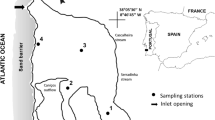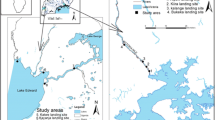Abstract
Analyses of the pigmentation stages and the size of glass eels during the arrival period to two northwestern Iberian estuaries (Ríos Nalón and Minho) and comparison of the patterns elucidated in this study with those reported for other geographical locations of the Atlantic and Mediterranean ranges showed nine pigmentation stages ranging from practically transparent to fully pigmented in the two-first locations. Overall, stage VB was predominant but within a broad variance across rivers and seasons. Consistent with previous studies, pigmentation stages tended to increase when the season progressed whilst, for a given individual length, mass tended to be higher during the early months of arrival. Moreover, both mass and condition factor were lower in individuals of advanced stages. Whilst we found no significant differences on glass eels length among pigmentation stages, both mass and condition factor were lower in more pigmented individuals. Given that larger glass eels with better physical condition may reveal greater energy content implying improved upstream migration earlier individuals may be better migrants than latter individuals.





Similar content being viewed by others
References
Antunes, J. C., 2002. Monitoring of glass eels recruitment in Portugal. In Dekker, W. (ed.), Monitoring of Glass Eels Recruitment. Netherlands Institute of Fisheries Research, Ijmuiden, Report C007/02-WD: 219–226.
Bardonnet, A. & P. Riera, 2005. Feeding of glass eels (Anguilla anguilla) in the course of their estuarine migration: new insights from stable isotope analysis. Estuarine, Coastal and Shelf Science 63: 201–209.
Bardonnet, A., S. Dasse, M. Parade & M. Heland, 2003. Influence del′alternance jour/nuit sur les desplacements de civelles en fluvarium. Bulletin Français de la Pêche et de la Pisciciculture 368: 9–20.
Boëtius, J., 1976. Anguilla anguilla and Anguilla rostrata from two Danish localities. Size, body mass, developmental stage and number of vertebrae related to time of ascent. Meddelelser fra Danmarks Fiskeri-Og Havundersogelser 7: 199–220.
Boëtius, I. & J. Boëtius, 1989. Ascending elvers, Anguilla anguilla, from five European localities. Analyses of pigmentation stages, condition, chemical composition and energy reserves. Dana 7: 1–12.
Bonhommeau, S., E. Chassot & E. Rivot, 2008. Fluctuations in European eel (Anguilla anguilla) recruitment resulting from environmental changes in the Sargasso Sea. Fisheries Oceanography 17: 32–44.
Briand, C., D. Fatin, E. Cicotti & P. Lambert, 2005. A stage-structure model to predict the effect of temperature and salinity on glass eel Anguilla anguilla pigmentation development. Journal of Fish Biology 67: 993–1009.
Bureau du Colombier, S., V. Bolliet, P. Lambert & A. Bardonnet, 2007. Energy and migratory behavior in glass eels (Anguilla anguilla). Physiology & Behavior 92: 684–690.
Charlon, N. & J. M. Blanc, 1982. Etude des civelles d’Anguilla anguilla L. dans la région du bassin de l’Adour. Archiv für Hydrobiologie 93: 238–255.
de Casamajor, M. N., P. Prouzet & P. Lazure, 2000. Identification des flux de civelles (Anguilla angilla) à partir des relations d′allométrie en fonction des conditions hydrodynamiques de l′estuarie de l′Adour. Aquatic Living Resources 13: 411–420.
de Casamajor, M. N., R. Lecomte-Finiger & P. Prouzet, 2003. Caracteristiques biologiques des civelles (Anguilla anguilla) lors de la transition en estuaire. Bulletin Français de la Pêche et de la Pisciciculture 368: 109–124.
Dekker, W., 2003. Status of the European eel stock and fisheries. In Aida, K., K. Tsukamoto & K. Yanauchi (eds), Eel Biology. Springer-Verlag, Tokyo: 237–254.
Desaunay, Y. & D. Guerault, 1997. Seasonal and long-term changes in biometrics of eel larvae: a possible relationship between recruitment variation and North Atlantic ecosystem productivity. Journal of Fish Biology 51: 317–339.
Elie, P., 1979. Contribution à l’étude des montées de civelles d’Anguilla anguilla L. dans l’estuaire de la Loire : Pêche, écophysiologie et èlevage. Thèse de 3eme Cycle Universitè Rennes I, 383 pp.
Elie, P., R. Lecomte-Finiger, I. Cantrelle & N. Charlon, 1982. Définition des limites des différentes stades pigmentaires durant la phase civelle d’Anguilla anguilla L (Poisson, Téléostéen, Anguilliformes). Vie et Mileu 32: 149–157.
Friedland, K. D., M. J. Miller & B. Knights, 2007. Oceanic changes in the Sargasso Sea and declines in recruitment of the European eel. ICES Journal of Marine Science 64: 519–530.
Gandolfi, G., M. Pesaro & P. Tongiori, 1984. Environmental factors affecting the ascent of elvers, Anguilla anguilla (L.). Oebalia 10: 17–35.
Gandolfi-Hornyold, A., 1918. Algunas medidas de las angulas de Santander. Boletín de Pescas 21: 153–192.
Gandolfi-Hornyold, A., 1920. Algunas observaciones sobre la angula en Palma de Mallorca. Boletín de Pescas 41-42-43: 1–128.
Gandolfi-Hornyold, A., 1929. Mensurations de civelles de l’Oria pendant la saison de pêche 1928–29. Bulletin de la Société d’Océanographie de France 49: 897–908.
Gandolfi-Hornyold, A., 1930a. Mensurations de civelles de Mex pêchées en mars 1928, près d’Alexandrie. Bulletin de la Société d’Océanographie de France 51: 936–940.
Gandolfi-Hornyold, A., 1930b. Mensurations de civelles de l’Oria pendant les saisons de pêches 1928–1929 et 1930–1931. Bulletin de la Société d’Océanographie de France 56: 1012–1023.
Gandolfi-Hornyold, A., 1936. La civelle d’Aguinaga de 1935 à 1936. Bulletin de la Société d’Océanographie de France 92: 1597–1599.
Kettle, A. J. & K. Haines, 2006. How does the European eel (Anguilla anguilla) retain its population structure during its larval migration across the Northern Atlantic Ocean? Canadian Journal of Fisheries and Aquatic Sciences 63: 90–106.
Lambert, P., M. Sabih, E. Rochard, J. Marchelidon, S. Dufour & P. Elie, 2003. Variabilite morphlogique et du taux d’hormone de croissance des civelles d’anguilles europeennes (Anguilla anguilla) dans l’estuaire de la Gironde au cours de la saison 1997–1998. Bulletin Français de la Pêche et de la Pisciciculture 368: 69–84.
Lara, M. J., 1994. Catch statistics, capture methods, size, and development stages of glass eels in Asturias (northwestern Spain). Bulletin of the Sea Fisheries Institute 1: 31–39.
Lecomte-Finiger, R., Y. Desaunay, D. Guerault & P. Grellier, 1996. The inmigration of Anguilla anguilla (L.) glass eels in coastal waters: questions about the determinism of the otolith structures. Archives of Polish Fisheries 4: 235–243.
Maes, G. E., B. Van Vo, A. J. Crivelli & F. A. M. Volckaert, 2009. Morphological and genetic seasonal dynamics of European eel Anguilla anguilla recruitment in southern France. Journal of Fish Biology 74: 2047–2068.
Poole, W.R., 1994. A population study of the European Eel (Anguilla anguilla (L.)) in the Burrishoole System, Ireland, with special reference to growth and movement. PhD Thesis, Dublin University, Ireland: 416 pp.
Strubberg, A., 1913. The metamorphosis of elvers as influenced by outward conditions. Meddelelser fra Kommissionen for Havundersogelser, Serie Fiskeri 4: 1–11.
Tesch, F. W., 2003. The Eel: Biology and Management of Anguillid Eels, 5th ed. Blackwell Science, Oxford.
Weber, M., 1986. Fishing method and seasonal occurrence of glass eels (Anguilla anguilla L.) in the river Minho, west coast of the Iberian Peninsula. Vie et Milieu 36: 243–250.
Yahyaoui, A., P. Aguesse & P. Beaubrun, 1983. Etude du recrutement en civelles (Anguilla anguilla L., 1758) dans l’estuaire du Sebou au de la saison de peche 1980–1981. Boletin de l’Institute Scientifique, Rabat 7: 149–164.
Zar, J. H., 1999. Biostatistical Analysis, 4th ed. Prentice-Hall, Inc., Upper Saddle River, NJ.
Acknowledgments
Thanks are due to the fishermen of the two rivers and very especially to Pepín “El Ruleru” and Ester Diaz (staff of the Río Nalón Fishermen Association) and to Alfredo Oliveira and Eduardo Martins (members of the Río Minho fishery crew) for their continuous help during glass eels collection. Brian Knights gave valuable comments on an earlier draft and Maite Lavandeira made her best to improve the English. During this study T. Iglesias was funded by the INDICANG Project of the INTERREG IIB—EU Program whereas S. Costa Dias was funded by the Portuguese FCT through the grant Ref. No. SFRH/BD/16922/2004.
Author information
Authors and Affiliations
Corresponding author
Additional information
Handling editor: M. Power
Rights and permissions
About this article
Cite this article
Iglesias, T., Lobón-Cerviá, J., Dias, S.C. et al. Variation of life traits of glass eels of Anguilla anguilla (L.) during the colonization of Ríos Nalón and Minho estuaries (northwestern Iberian Peninsula). Hydrobiologia 651, 213–223 (2010). https://doi.org/10.1007/s10750-010-0300-1
Received:
Revised:
Accepted:
Published:
Issue Date:
DOI: https://doi.org/10.1007/s10750-010-0300-1




